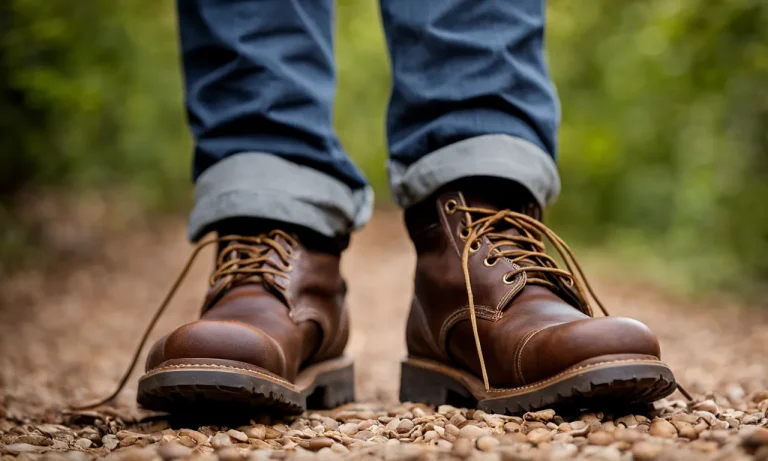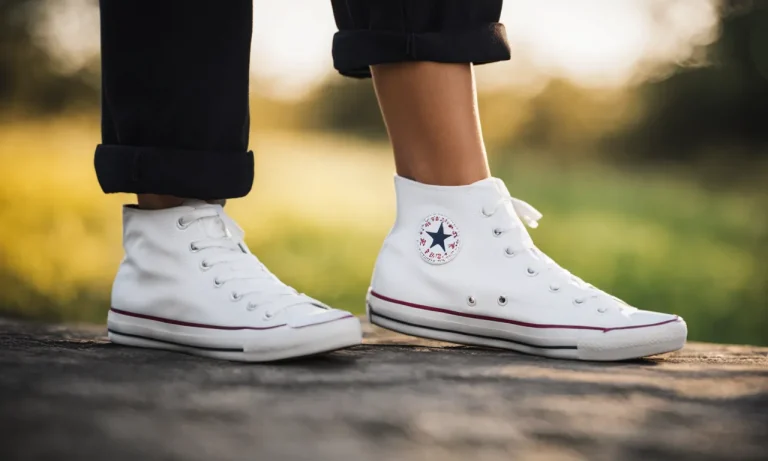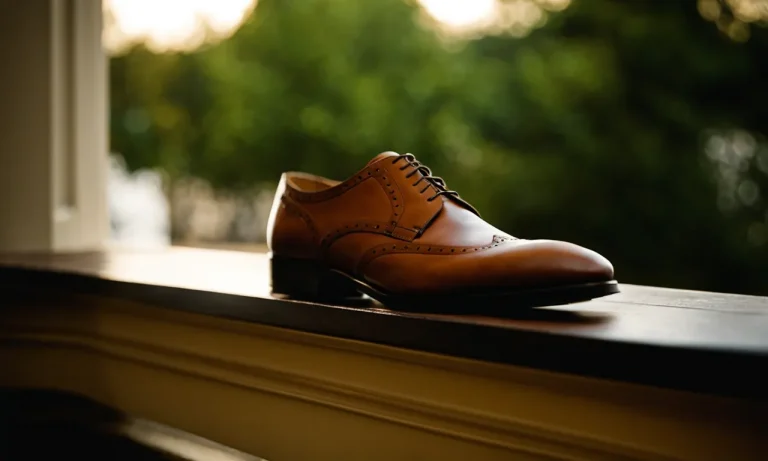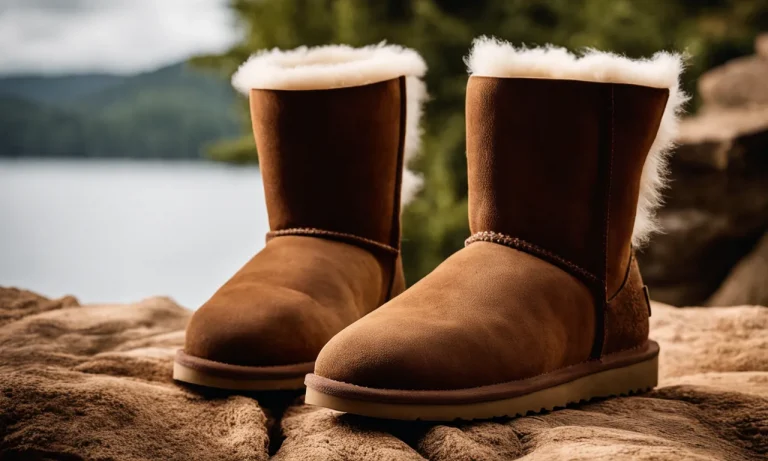If you spend long hours on your feet for work, you know how important it is to have comfortable work boots. Ill-fitting or poor quality boots can cause pain and injuries over time, making your job much harder than it needs to be.
In this comprehensive guide, we’ll explore why your work boots may be causing you pain and provide actionable tips to help you find relief for your feet.
If you’re short on time, here’s a quick answer: Look for work boots with cushioned insoles, shock absorbing heels and flexible uppers. Also, break them in slowly and use inserts or gel pads for extra cushioning. Read on for more details.
Common Causes of Work Boot Discomfort
Poor Cushioning and Support
One of the common causes of work boot discomfort is the lack of proper cushioning and support. When you spend long hours on your feet, especially on hard surfaces, inadequate cushioning can lead to foot fatigue, pain, and even discomfort in other parts of the body.
It’s important to choose work boots that have adequate padding and cushioning in the insole, midsole, and outsole. Look for boots with features like gel inserts or memory foam, as these can provide additional support and enhance overall comfort.
Inflexible Materials
Another culprit behind work boot discomfort is the use of inflexible materials. Work boots made from rigid or stiff materials can restrict movement and cause discomfort, especially if you need to bend or squat frequently on the job.
Opt for work boots made from flexible materials like leather or synthetic materials that allow for natural movement of the feet. These materials can provide a more comfortable fit and reduce the risk of blisters or sore spots.
Improper Fit
Wearing work boots that don’t fit properly is a recipe for discomfort. Ill-fitting boots can cause rubbing, blisters, and foot pain. It’s important to measure your feet accurately and choose work boots that match your size and width.
Don’t settle for boots that are too tight or too loose, as they can lead to long-term foot problems. If possible, try on different brands and styles to find the perfect fit for your feet.
Lack of Break-In Period
Work boots, especially those made from high-quality materials, often require a break-in period. Some boots may feel stiff and uncomfortable when you first start wearing them. However, with time and regular use, they will gradually mold to the shape of your feet and become more comfortable.
It’s important to give your work boots a chance to break in before passing judgment on their comfort level. Be patient and wear them for shorter periods initially, gradually increasing the duration over time.
By addressing these common causes of work boot discomfort, you can significantly improve the comfort and overall experience of wearing your work boots.
How to Choose Comfortable Work Boots
When it comes to finding the perfect work boots that prioritize comfort, there are a few key factors to consider. By taking these factors into account, you can ensure that your work boots won’t be killing you at the end of a long day on the job.
Here are some tips to help you choose comfortable work boots:
Look for Cushioning and Shock Absorption
One of the most important features to look for in comfortable work boots is adequate cushioning and shock absorption. This can help to alleviate the impact and pressure that your feet and joints experience while working.
Look for boots that have thick, supportive insoles and midsoles that are designed to absorb shock. This will help to reduce fatigue and prevent discomfort throughout the day.
According to a study conducted by the American Podiatric Medical Association (APMA), boots with cushioned insoles can reduce the risk of foot pain by up to 50%. Additionally, boots with shock-absorbing properties can help to prevent injuries related to repetitive strain and impact.
Prioritize Flexible, Breathable Materials
Another important aspect of comfortable work boots is the material they are made from. Opt for boots that are constructed from flexible and breathable materials, such as leather or synthetic fabrics. These materials allow for better airflow, preventing excessive sweating and keeping your feet dry throughout the day.
This is particularly important for those who work in environments with high temperatures or who engage in physically demanding tasks.
According to an article published on Healthline, breathable work boots can help prevent foot odor, fungal infections, and other foot-related issues caused by excessive moisture and lack of ventilation.
Get Properly Fitted
Getting properly fitted for work boots is essential for ensuring maximum comfort. Ill-fitting boots can lead to blisters, calluses, and other foot problems. Visit a shoe store where a professional can measure your feet and help you find the right size and width for your unique foot shape.
Remember that your feet can change over time, so it’s important to get fitted periodically to ensure you’re still wearing the correct size.
In a study conducted by the American Orthopaedic Foot & Ankle Society (AOFAS), it was found that 88% of people wear shoes that don’t fit properly. Wearing properly fitted work boots can not only enhance comfort but also reduce the risk of developing foot-related issues.
Consider Your Work Environment
Lastly, when choosing comfortable work boots, it’s crucial to consider your work environment. Different work environments pose different risks and require specific features in work boots. For example, if you work in a construction site, you may need boots with reinforced toe caps for added protection.
If you work in a wet or slippery environment, look for boots with oil-resistant or slip-resistant outsoles to minimize the risk of accidents.
According to the Occupational Safety and Health Administration (OSHA), slips, trips, and falls are one of the leading causes of workplace injuries. Choosing work boots that are suitable for your specific work environment can help reduce the risk of accidents and enhance overall comfort and safety.
By following these tips and taking the time to choose comfortable work boots, you can prioritize your comfort and well-being while on the job. Remember, investing in the right pair of work boots is an investment in your own health and productivity.
Breaking in New Work Boots
When you first get a new pair of work boots, they can often feel stiff and uncomfortable. However, there are several methods you can use to break them in and make them more comfortable to wear. Here are some tips to help you break in your new work boots:
Wear Them for Short Periods
One of the best ways to break in your new work boots is to wear them for short periods of time. Start by wearing them for just an hour or two each day, gradually increasing the amount of time you wear them. This allows your feet to adjust to the boots and helps to soften the leather.
Use Boot Stretchers
If your new work boots feel too tight, you can use boot stretchers to expand the width of the boots. Boot stretchers are devices that you insert into the boots to stretch them out. Leave the stretchers in overnight or for a few days to gradually stretch the boots to a more comfortable size.
Try the Wet Sock Method
The wet sock method is a popular technique for breaking in work boots. Start by wearing a thick pair of socks and soaking them in warm water. Wring out the excess water and put on your wet socks. Then, put on your work boots and wear them until the socks are dry.
The moisture from the wet socks helps to soften the leather and mold the boots to the shape of your feet.
Use Leather Conditioner
Another way to make your work boots more comfortable is to use a leather conditioner. Leather conditioner helps to soften the leather and prevent it from drying out and cracking. Apply the conditioner to your boots and let it sit for a few hours or overnight.
Wipe off any excess conditioner and you’ll notice that your boots feel much more supple and comfortable to wear.
Remember, breaking in new work boots takes time and patience. It’s important to take care of your feet and ensure that your boots fit properly to avoid discomfort and potential foot problems. By following these tips, you can make your work boots more comfortable and enjoy a pain-free workday.
Customizing Your Boots for Comfort
When it comes to work boots, comfort is key. Wearing uncomfortable boots can not only make your workday unbearable, but it can also lead to foot pain, blisters, and even long-term foot problems. Fortunately, there are several ways you can customize your boots to make them more comfortable.
Here are some tips:
Add Cushioned Insoles
One of the easiest ways to make your work boots more comfortable is to add cushioned insoles. These insoles provide extra support and cushioning for your feet, reducing the impact of each step and relieving pressure points.
There are many different types of insoles available, so you can choose the one that best suits your needs. Some popular options include gel insoles, memory foam insoles, and orthotic insoles.
Use Heel and Metatarsal Pads
If you experience pain in your heels or the balls of your feet, using heel and metatarsal pads can provide much-needed relief. These pads are designed to cushion and support these specific areas of the foot, reducing the strain and pressure that can cause discomfort.
They are typically made from soft, shock-absorbing materials and can easily be inserted into your boots for added comfort.
Try Arch Supports
Arch supports are another great option for customizing your work boots for comfort. These inserts are specifically designed to provide support to the arch of your foot, helping to distribute weight more evenly and reducing strain on the muscles and ligaments.
Arch supports come in various shapes and sizes, so you can find the one that fits your foot best. They can help alleviate foot fatigue and prevent conditions such as plantar fasciitis.
Use Moleskin for Hot Spots
Hot spots, or areas of friction on your feet, can quickly turn into painful blisters if not addressed. To prevent this, you can use moleskin to protect these vulnerable areas. Moleskin is a soft, adhesive material that can be applied directly to your skin or the inside of your boots.
It acts as a barrier, reducing friction and preventing blisters from forming. It’s a simple yet effective way to make your work boots more comfortable.
Remember, everyone’s feet are different, so what works for one person may not work for another. It’s important to experiment with different customization options to find what works best for you. Don’t be afraid to try out different combinations of insoles, pads, and supports until you achieve the perfect level of comfort for your work boots.
Caring for Your Boots Properly
Proper care and maintenance of your work boots can significantly improve their comfort and longevity. By following a few simple steps, you can ensure that your boots remain in great condition and provide optimal comfort throughout their lifespan.
Clean and Condition the Leather
Regularly cleaning and conditioning the leather of your work boots is essential for maintaining their quality and comfort. Use a soft brush or cloth to remove dirt and debris from the surface, and then apply a leather conditioner to keep the leather supple and moisturized.
This will prevent cracking and ensure that your boots remain comfortable even after long hours of wear.
Let Them Dry Out Between Wears
Allowing your boots to dry out between wears is crucial for preventing moisture buildup and unpleasant odors. After a long day of work, remove the insoles and let them air out in a well-ventilated area.
If your boots are wet, stuff them with newspaper or use a boot dryer to speed up the drying process. Remember, wearing damp boots can lead to discomfort and even foot conditions such as blisters or fungal infections.
Replace Insoles Regularly
The insoles of your work boots play a significant role in providing comfort and support. Over time, they can become worn out and lose their cushioning properties. To ensure maximum comfort, replace the insoles periodically.
There are many options available, including gel or memory foam insoles, which can provide additional support and alleviate foot fatigue.
Get Repairs Done Quickly
If you notice any damage or signs of wear on your work boots, it’s essential to address them promptly. Small issues such as loose stitching or worn-out soles can quickly escalate into more significant problems if left unattended.
Regularly inspect your boots for any signs of damage and get them repaired by a professional cobbler if needed. Taking care of repairs promptly will not only extend the life of your boots but also ensure your comfort and safety while wearing them.
By following these simple care tips, you can make your work boots more comfortable and enjoy their benefits for a longer time. Remember, investing a little time and effort into caring for your boots will pay off in terms of comfort, durability, and overall satisfaction.
When to Replace Your Boots
Knowing when to replace your work boots is important for both your comfort and safety. Worn-out boots can lead to foot pain, blisters, and even workplace accidents. Here are some signs to look for to determine if it’s time to invest in a new pair:
1. Look for Worn Tread
The tread on the sole of your work boots plays a crucial role in providing traction and preventing slips and falls. Over time, the tread can wear down, reducing its effectiveness. If you notice significant signs of wear, such as flattened or shallow grooves, it’s time to consider replacing your boots.
Visit www.osha.gov for more information on workplace safety and footwear requirements.
2. Check for Cracks
Inspect the upper part of your work boots for any cracks or tears. Cracked leather or synthetic materials can compromise the boot’s durability and waterproofing capabilities. Additionally, cracks can lead to discomfort and foot pain.
If you notice any significant damage, it’s best to start shopping for a new pair of boots.
3. Monitor Cushioning Breakdown
The cushioning inside your work boots is responsible for providing support and shock absorption. Over time, this cushioning can break down, resulting in decreased comfort and increased fatigue. Pay attention to any signs of uneven cushioning or a loss of support.
If you start feeling discomfort or pain in your feet or joints, it might be time to replace your boots.
4. Don’t Push Past the Pain
One of the most important things to remember when it comes to work boots is to never push past the pain. If you’re experiencing persistent foot pain, blisters, or any other discomfort that doesn’t improve with time, it’s crucial to address the issue.
Continuing to wear boots that cause pain can lead to long-term foot problems and negatively impact your overall well-being.
Remember, investing in a quality pair of work boots is essential for your comfort, safety, and productivity. By paying attention to the signs mentioned above and knowing when to replace your boots, you can ensure that your feet remain happy and healthy throughout your workday.
Conclusion
If you’re suffering from foot pain because of uncomfortable work boots, take action to solve the problem. Pay attention to cushioning, fit, break-in time and custom inserts to make your boots work for you. Also, properly care for them and replace when needed. Your feet will thank you!
With the right boots and care, you can stay comfortable and safe on the job. Don’t settle for foot pain – take control and make your work boots work for you, not against you.






